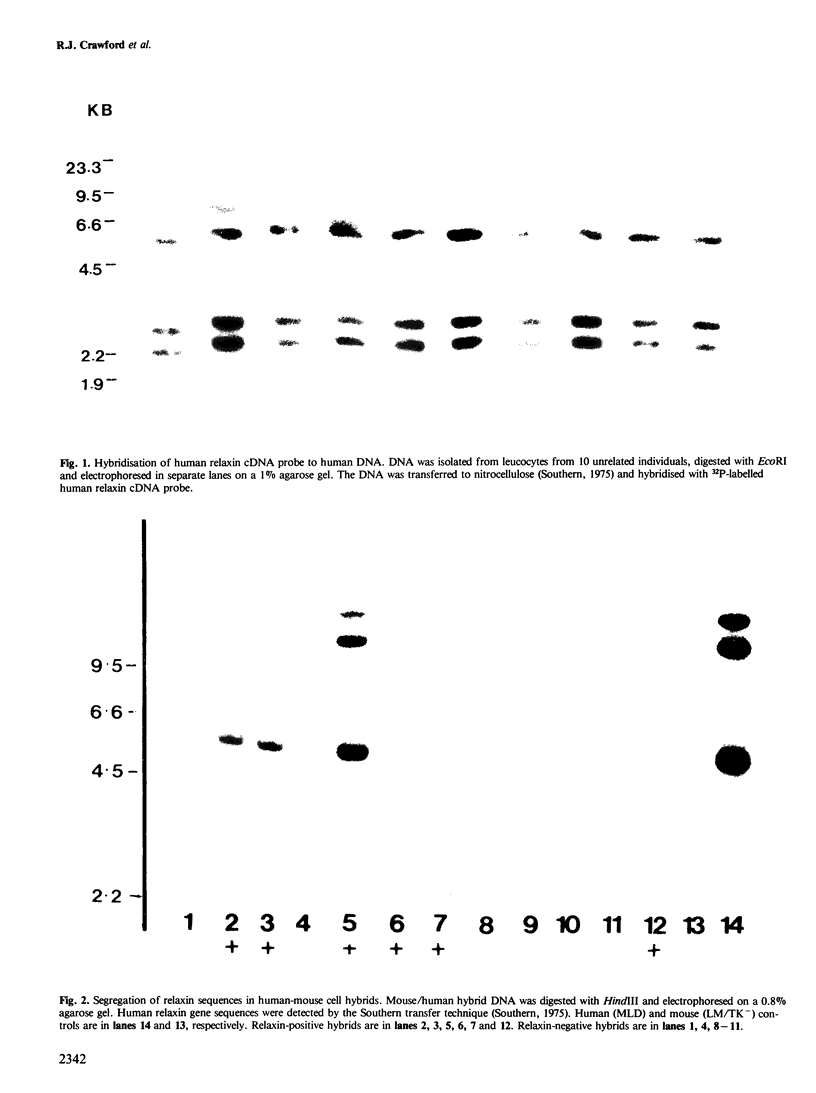Abstract
We have recently cloned two different human relaxin gene sequences. One of these (H1) was isolated from a human genomic clone bank and the other (H2) from a cDNA library prepared from human pregnant ovarian tissue. Southern gel analysis of the relaxin genes within the genomes of several unrelated individuals showed that all genomes contained both relaxin genes. Hence it is unlikely (p less than 0.001) that the two relaxin gene sequences are alleles. Rather, it is probable that there are two relaxin genes within the human genome. It is likely that relaxin and insulin genes have evolved from a common ancestral gene by gene duplication, since structural similarities between insulin and relaxin are evident at both the peptide and gene level. To investigate the evolutionary relationship between the two human relaxin genes and the insulin gene, we have determined the chromosomal position of the relaxin genes using mouse/human cell hybrids. We found that the human insulin and relaxin genes are on different chromosomes. Both human relaxin genes are located on the short arm region of chromosome 9.
Full text
PDF




Images in this article
Selected References
These references are in PubMed. This may not be the complete list of references from this article.
- Barta A., Richards R. I., Baxter J. D., Shine J. Primary structure and evolution of rat growth hormone gene. Proc Natl Acad Sci U S A. 1981 Aug;78(8):4867–4871. doi: 10.1073/pnas.78.8.4867. [DOI] [PMC free article] [PubMed] [Google Scholar]
- Bryant-Greenwood G. D. Relaxin as a new hormone. Endocr Rev. 1982 Winter;3(1):62–90. doi: 10.1210/edrv-3-1-62. [DOI] [PubMed] [Google Scholar]
- Chan S. J., Keim P., Steiner D. F. Cell-free synthesis of rat preproinsulins: characterization and partial amino acid sequence determination. Proc Natl Acad Sci U S A. 1976 Jun;73(6):1964–1968. doi: 10.1073/pnas.73.6.1964. [DOI] [PMC free article] [PubMed] [Google Scholar]
- Essig M., Schoenfeld C., D'Eletto R. T., Amelar R., Steinetz B. G., O'Byrne E. M., Weiss G. Relaxin in human seminal plasma. Ann N Y Acad Sci. 1982;380:224–230. doi: 10.1111/j.1749-6632.1982.tb18045.x. [DOI] [PubMed] [Google Scholar]
- Hudson P., Haley J., John M., Cronk M., Crawford R., Haralambidis J., Tregear G., Shine J., Niall H. Structure of a genomic clone encoding biologically active human relaxin. Nature. 1983 Feb 17;301(5901):628–631. doi: 10.1038/301628a0. [DOI] [PubMed] [Google Scholar]
- Jeffreys A. J., Wilson V., Wood D., Simons J. P., Kay R. M., Williams J. G. Linkage of adult alpha- and beta-globin genes in X. laevis and gene duplication by tetraploidization. Cell. 1980 Sep;21(2):555–564. doi: 10.1016/0092-8674(80)90493-6. [DOI] [PubMed] [Google Scholar]
- Lalley P. A., Brown J. A., Eddy R. L., Haley L. L., Byers M. G., Goggin A. P., Shows T. B. Human beta-glucuronidase: assignment of the structural gene to chromosome 7 using somatic cell hybrids. Biochem Genet. 1977 Apr;15(3-4):367–382. doi: 10.1007/BF00484467. [DOI] [PubMed] [Google Scholar]
- Lalley P. A., Brown J. A., Shows T. B. Assignment of hexosaminidase-B to chromosome 5, its segregation after diphtheria toxin selection, and the linkage of hexosaminidase-A, mannose phosphate isomerase, and pyruvate kinase (M2). Cytogenet Cell Genet. 1976;16(1-5):188–191. doi: 10.1159/000130587. [DOI] [PubMed] [Google Scholar]
- Naylor S. L., Elliott R. W., Brown J. A., Shows T. B. Mapping of aminoacylase-1 and beta-galactosidase-A to homologous regions of human chromosome 3 and mouse chromosome 9 suggests location of additional genes. Am J Hum Genet. 1982 Mar;34(2):235–244. [PMC free article] [PubMed] [Google Scholar]
- Owerbach D., Bell G. I., Rutter W. J., Brown J. A., Shows T. B. The insulin gene is located on the short arm of chromosome 11 in humans. Diabetes. 1981 Mar;30(3):267–270. doi: 10.2337/diab.30.3.267. [DOI] [PubMed] [Google Scholar]
- Owerbach D., Bell G. I., Rutter W. J., Shows T. B. The insulin gene is located on chromosome 11 in humans. Nature. 1980 Jul 3;286(5768):82–84. doi: 10.1038/286082a0. [DOI] [PubMed] [Google Scholar]
- Rigby P. W., Dieckmann M., Rhodes C., Berg P. Labeling deoxyribonucleic acid to high specific activity in vitro by nick translation with DNA polymerase I. J Mol Biol. 1977 Jun 15;113(1):237–251. doi: 10.1016/0022-2836(77)90052-3. [DOI] [PubMed] [Google Scholar]
- Sakaguchi A. Y., Shows T. B. Coronavirus 229E susceptibility in man-mouse hybrids is located on human chromosome 15. Somatic Cell Genet. 1982 Jan;8(1):83–94. doi: 10.1007/BF01538652. [DOI] [PMC free article] [PubMed] [Google Scholar]
- Seeburg P. H. The human growth hormone gene family: nucleotide sequences show recent divergence and predict a new polypeptide hormone. DNA. 1982;1(3):239–249. doi: 10.1089/dna.1.1982.1.239. [DOI] [PubMed] [Google Scholar]
- Shows T. B., Brown J. A., Haley L. L., Byers M. G., Eddy R. L., Cooper E. S., Goggin A. P. Assignment of the beta-glucuronidase structural gene to the pter leads to q22 region of chromosome 7 in man. Cytogenet Cell Genet. 1978;21(1-2):99–104. doi: 10.1159/000130882. [DOI] [PubMed] [Google Scholar]
- Shows T. B., Brown J. A. Mapping chromosomes 1 and 2 employing a 1/2 translocation in somatic cell hybrids. Birth Defects Orig Artic Ser. 1975;11(3):251–255. [PubMed] [Google Scholar]
- Shows T. B. Genetics of human-mouse somatic cell hybrids: linkage of human genes for lactate dehydrogenase-A and esterase-A 4 . Proc Natl Acad Sci U S A. 1972 Feb;69(2):348–352. doi: 10.1073/pnas.69.2.348. [DOI] [PMC free article] [PubMed] [Google Scholar]
- Shows T. B., Sakaguchi A. Y., Naylor S. L., Goedell D. V., Lawn R. M. Clustering of leukocyte and fibroblast interferon genes of human chromosome 9. Science. 1982 Oct 22;218(4570):373–374. doi: 10.1126/science.6181564. [DOI] [PubMed] [Google Scholar]
- Shows T. B., Sakaguchi A. Y., Naylor S. L. Mapping the human genome, cloned genes, DNA polymorphisms, and inherited disease. Adv Hum Genet. 1982;12:341–452. doi: 10.1007/978-1-4615-8315-8_5. [DOI] [PubMed] [Google Scholar]
- Shows T. B., Scrafford-Wolff L. R., Brown J. A., Meisler M. H. GM1-gangliosidosis: chromosome 3 assignment of the beta-galactosidase-A gene (beta GALA). Somatic Cell Genet. 1979 Mar;5(2):147–158. doi: 10.1007/BF01539157. [DOI] [PubMed] [Google Scholar]
- Southern E. M. Detection of specific sequences among DNA fragments separated by gel electrophoresis. J Mol Biol. 1975 Nov 5;98(3):503–517. doi: 10.1016/s0022-2836(75)80083-0. [DOI] [PubMed] [Google Scholar]
- Talmadge K., Vamvakopoulos N. C., Fiddes J. C. Evolution of the genes for the beta subunits of human chorionic gonadotropin and luteinizing hormone. Nature. 1984 Jan 5;307(5946):37–40. doi: 10.1038/307037a0. [DOI] [PubMed] [Google Scholar]
- Wigler M., Sweet R., Sim G. K., Wold B., Pellicer A., Lacy E., Maniatis T., Silverstein S., Axel R. Transformation of mammalian cells with genes from procaryotes and eucaryotes. Cell. 1979 Apr;16(4):777–785. doi: 10.1016/0092-8674(79)90093-x. [DOI] [PubMed] [Google Scholar]




